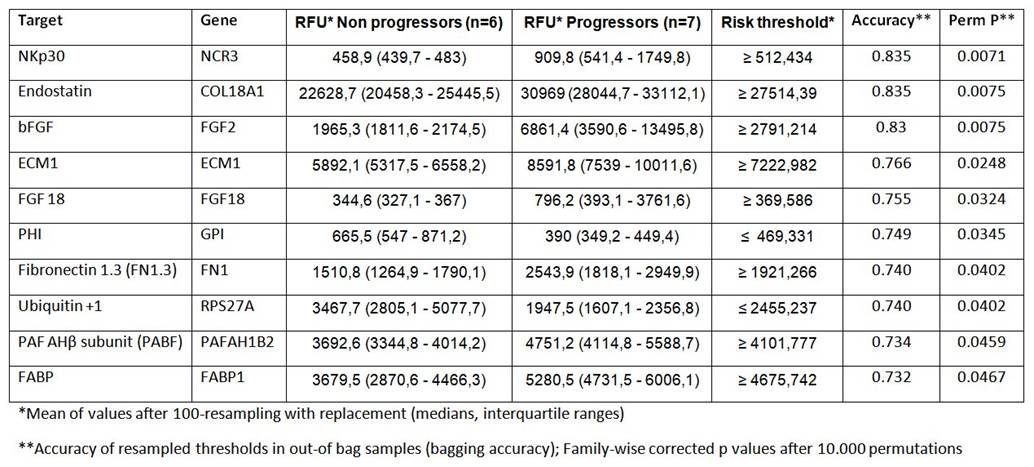Session Information
Date: Monday, October 22, 2018
Title: Systemic Sclerosis and Related Disorders – Basic Science Poster II
Session Type: ACR Poster Session B
Session Time: 9:00AM-11:00AM
Background/Purpose: To determine via SOMAscan aptamer proteomic analysis (>1200 proteins analyzed) the factors associated with disease transition from very early systemic sclerosis (EaSSc) to definite SSc.
Methods: Serum samples from 13 EaSSc, defined according to LeRoy and Medsger criteria (Raynaud phenomenon plus a positive nailfold capillaroscopy and SSc specific auto-antibodies without any other sign of definite disease) [1] and 8 age-, sex-matched healthy controls (HCs) were analyzed via SOMAscan aptamer assay [2]. Prospective data were available up to 4.9 years from sampling (median=4.1, IQR=3.5-4.5 yrs) to determine the progression to definite SSc according to the EULAR/ACR 2013 criteria [3]. Relevant proteins were selected among those with relative fluorescence units (RFU) > 1.5-fold HCs via predictive modeling (bagging). Gene Ontologies (GO terms) of proteins with corrected p<0.05 after 10.000-fold permutation testing, were aggregated to determine the relevance of biological processes in patients at risk of evolution.
Results: Seven patients (54%) did evolve into definite SSc, while 6 did not progress. Non progressors and progressors were similar regarding baseline characteristics (ACA+, 66% vs 57%; FVC, 105 [97-102] vs 110 [109-115]; DLco, 92 [87-105] vs 85 [82-101]). Ten proteins were significantly associated with evolution (Table); their relative RFUs are represented via heatmaps in Figure, left panel. GO term analysis revealed that patients at risk for progression shared several biological processes (Figure, right panel) related to fibrosis, vascular function and angiogenesis and that these were upregulated compared to non-progressors.
Conclusion: Increased expression of proteins and pathways related to angiogenesis, extracellular matrix remodeling and fibrosis distinguish EaSSc at risk of progression from those with stable disease up to 5 years from referral. This is the very first proteomic study to determine the baseline factors associated with disease evolution in very early SSc patients. Our findings may have relevance for early therapeutic intervention and disease interception.
Table – Selected proteins
Figure – Heatmaps of normalized RFU (left) and related GO-terms
References
1. LeRoy EC, et al. J Rheumatol. 2001;28:1573-6.
2. Gold L, et al. PLoS One. 2010;5:e15004.
3. van den Hoogen F, et al. Arthritis Rheum. 2013;65:2737-47.
To cite this abstract in AMA style:
Bellocchi C, Assassi S, Ying J, Mohan C, Santaniello A, Beretta L. Proteomic Aptamer Analysis Reveals a Distinct Profile of Very Early Systemic Sclerosis (SSc) Patients at Risk for Progression Toward Definite SSc [abstract]. Arthritis Rheumatol. 2018; 70 (suppl 9). https://acrabstracts.org/abstract/proteomic-aptamer-analysis-reveals-a-distinct-profile-of-very-early-systemic-sclerosis-ssc-patients-at-risk-for-progression-toward-definite-ssc/. Accessed .« Back to 2018 ACR/ARHP Annual Meeting
ACR Meeting Abstracts - https://acrabstracts.org/abstract/proteomic-aptamer-analysis-reveals-a-distinct-profile-of-very-early-systemic-sclerosis-ssc-patients-at-risk-for-progression-toward-definite-ssc/


